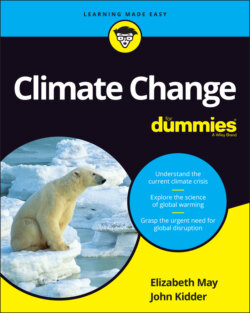Читать книгу Climate Change For Dummies - Elizabeth May - Страница 79
Cutting back on carbon
ОглавлениеModern civilization probably won’t stop producing GHG emissions altogether. But to stop levels from passing much farther toward 420 ppm — and thus limit the world to a 2.7-degreesFahrenheit (1.5 degrees C) temperature rise — emissions must decline rapidly. The IPCC has laid out that the only pathway to holding to a safer temperature rise of 2.7 degrees F (1.5 degrees C) requires a 50 percent cut in carbon dioxide below 2010 levels by 2030. (See Chapter 11 for more about international climate change agreements.)
Modified and based on Figure 3.6. Climate Change 2007: Synthesis Report. Fourth Assessment Report. IPCC. Cambridge University Press.
FIGURE 3-4: Effects from climate change will intensify as temperatures rise.
Deep emissions reductions are humanity’s best choice because it’s the safest route to take. Some argue that such cuts will be too disruptive to the economy. (We consider ways that governments can help lower emissions in Part 4, and in Part 5, we look at how businesses and individuals can cut back on emissions.)
The IPCC recommends reducing carbon emissions to net zero by 2050, on top of cutting them in half by 2030. Many countries and groups have committed to an aggressive 2050 goal independently, including the European Union, California, and the World Mayors Council. (See Chapter 10 for solutions being implemented by governments around the world.)
The main reason a major reduction in GHG emissions is so important is because a chance exists that the planet’s climate situation could get worse than predicted. For example, the Earth is experiencing changes that speed up the warming cycle because of positive feedback loops (see Chapter 7 to find out about these feedback loops), or because parts of the carbon cycle are weakening because of increasing temperatures, meaning that not as much carbon is being sucked up by carbon sinks such as forests and oceans — leaving humans to deal with more emissions than expected. (The precautionary principle, which we talk about in the section, “Going, going, gone … The tipping point,” earlier in this chapter, looks more appealing by the day!)
Humanity needs to remember that we don’t start with a clean slate every year. We carry a burden from the history of burning fossil fuels. Every time a person drives an internal combustion vehicle, for example, they release carbon dioxide that will act as a force for global warming for the next 100 years.
The global climate system has long lag times. The atmosphere doesn’t turn on a dime. The damage humanity does today will have an effect over a century. If people keep on with business as usual, we run a real risk of losing a functional civilization. We have to stay positive and work to move governments and industry — and all of us — to push for the changes that need to be made.
